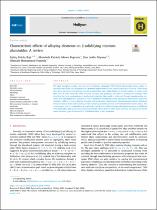 ResearchSpace
ResearchSpace
Characterization of surface liquid segregation in SSM-HPDC aluminium alloys 7075, 2024, 6082 and A201
JavaScript is disabled for your browser. Some features of this site may not work without it.
- ResearchSpace
- →
- Research Publications/Outputs
- →
- Journal Articles
- →
- View Item
Characterization of surface liquid segregation in SSM-HPDC aluminium alloys 7075, 2024, 6082 and A201
Semi-solid metal (SSM) processing is a unique manufacturing method to produce near-net shape products for various industrial applications. The nature of the SSM slurry (with solid spherical grains suspended in a liquid), makes it susceptible to liquid segregation during forming processes such as high pressure die casting (HPDC). In this paper, the SLS phenomenon in SSM-HPDC plates of 7075, 2024, 6082 and A201 was investigated by means of different techniques. Depth profiles were determined by firstly measuring the chemical composition of the surface of the plates using a Thermo Quantris Optical Emission Spectrometer (OES). Material was then removed by a grinding process followed by measurement of the amount of material removed and chemical analysis. Chemical profiles of the main alloying elements were plotted for the cross-section of the plates in the as-cast and T6 (after solution treatment) temper conditions. Vickers hardness profiles from the surface to the centre of the plates were determined. Metallographic samples of cross-sections of the castings were prepared and evaluated using a scanning electron microscope. It is shown that surface liquid segregation in SSM-HPDC alloys causes significant differences in properties between the surface and the bulk of these castings in both the F and T6 temper conditions.
Reference:
Moller, H, Curle, UA and Masuku, EP. 2010. Characterization of surface liquid segregation in SSM-HPDC aluminium alloys 7075, 2024, 6082 and A201. Transactions of Nonferrous Metals Society of China, Vol. 20(3), pp s847-s851
Moller, H., Curle, U., & Masuku, E. (2010). Characterization of surface liquid segregation in SSM-HPDC aluminium alloys 7075, 2024, 6082 and A201. http://hdl.handle.net/10204/4377
Moller, H, UA Curle, and EP Masuku "Characterization of surface liquid segregation in SSM-HPDC aluminium alloys 7075, 2024, 6082 and A201." (2010) http://hdl.handle.net/10204/4377
Moller H, Curle U, Masuku E. Characterization of surface liquid segregation in SSM-HPDC aluminium alloys 7075, 2024, 6082 and A201. 2010; http://hdl.handle.net/10204/4377.
Copyright: 1997-2008 Editorial office of Transactions of Nonferrous Metals Society of China
Sep 2010
Semi-solid metal
Alloy 7075
Alloy 2024
Alloy 6082
Alloy A201
Surface liquid segregation
Nonferrous metals
Aluminium alloys
Alloy 7075
Alloy 2024
Alloy 6082
Alloy A201
Surface liquid segregation
Nonferrous metals
Aluminium alloys
Files in this item
Related Items
This item appears in the following Collection(s)
Related items
Showing items related by title, author, creator and subject.
-
Author: Raji, Sadiq Abiola ; Popoola, API ; Pityana, Sisa L ; Popoola, OM Date: Jul 2020 The high strength-to-weight ratio property of titanium aluminide (TiAl) based intermetallic alloys makes researchers regard this type of material as a potential replacement for the heavier superalloys of nickel. These alloys have been applied ... Read more
-
Author: Machio, Christopher N ; Nyabadza, D ; Sibanda, V ; Chikwanda, HK Date: May 2010 Face centred cubic Ti – 10 and 20 Mg and Ti-6Al-4Mg (wt. %) alloy powders have been produced by high energy ball milling, under argon, of elemental powder mixtures containing a process control agent (PCA). Milling leads to a multi-disperse ... Read more
-
Author: Moller, H ; Govender, G ; Stumpf, WE ; Pistorius, PC Date: 2010 The heat treatment response of semisolid metal high pressure die cast Al-7Si-Mg alloys A356 and F357 was studied and compared. It was found that the heat treatment behaviour of alloy F357 is influenced markedly by the stability of the Mg ... Read more
Browse
-
All of ResearchSpace
-
This Collection
Legislation and compliance
General Enquiries
Tel: + 27 12 841 2911
Email: callcentre@csir.co.za
Physical Address
Meiring Naudé Road
Brummeria
Pretoria
South Africa
Postal Address
PO Box 395
Pretoria 0001
South Africa
Copyright © CSIR 2017. All Rights Reserved
Resources on this site are free to download and reuse according to associated licensing provision. Please read the terms and conditions of usage of each resource.







